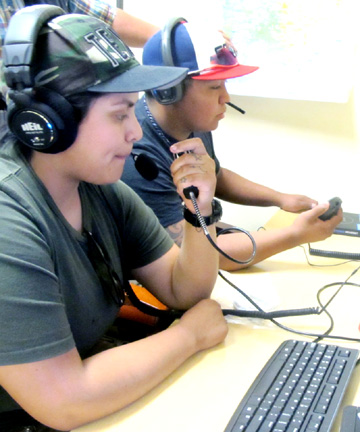How would you communicate from the reservation in the case of a widespread disaster?
After an earthquake, or during a major storm, when the internet, phones and power are not working—How could the emergency response teams communicate with each other?
The best way would be with an Amateur, or ‘ham’ radio.
The tribes’ Emergency Management Department, working with the Warm Springs Telecom, acquired one of these radios earlier this year.
The tribes made the purchase with a state grant, after Emergency Management director Dan Martinez lobbied on behalf of the tribes.
Law requires training and an FCC license before a person can operate a ham radio. Josh Richesin at the Telecom has a license, but it was important for Emergency Management to have licensed operates as well, Martinez was saying recently.
Lorena Medina and Neal MorningOwl were the perfect candidates, he said. And this month they both received their Amateur radio licenses.
They took the required course in Spokane during the 2016 Emergency Preparedness Conference, and received their licenses and call numbers last week. They can now operate the tribes’ Amateur radio system, housed at the Warm Springs Telecom.
Lorena and Neal are 2014 graduates of Madras High School. Neal has been working at Emergency Management for two years, and Lorena for five years. She started with the department as a summer youth worker while still in high school.
Warm Springs is now the only tribe in the U.S. with certification as a ham radio hub in case of emergency. Lorena is first Native American woman licensed to operate this type of radio.
Ham radio is the best form of communication during extreme emergencies because this type of radio can communicate for distances of hundreds, or even thousands of miles. By comparison, a walkie-talkie can reach in the range of around 30 miles.
The emergency response to Hurricane Katrina, and the 9-11 attack, for instance, relied on the ham radio operators.
Public safety radio
Over the past 10 years, Warm Springs Public Safety Branch and Emergency Management have been working to build out the public safety radio network on the reservation.
This is critical for the protection of the people reservation, enabling first-responders to have two-way, inter-operable communications.
The emergency preparedness team has built new towers, shared with the Warm Springs Telecom, to place the necessary equipment.
They have purchased new repeaters, hand-helds, and mobile equipment, meeting the new federal standards.
These upgrades ensure inter-operable communications between the various Warm Springs departments, including police and fire, and outside agencies.
The team secured the purchase of new dispatch consoles and software, and created a new inter-operable microwave link with the Jefferson County Sheriff’s Department.
All of these initiatives enhance the protection and safety of the people on the reservation.
The ham radio project is a recent example of this public safety program. A ham radio repeater was installed on Eagle Butte last year.
The tribes and Warm Springs Telecom developed a plan calling for the Telecom to serve as the back-up communication site and secondary command post for disaster preparedness and communications.
The two new licensed ham radio operators at Emergency Management are the most recent addition to the program.


